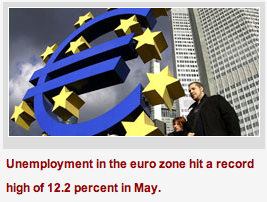
Almost everyone I talk to thinks the European sovereign debt crisis has passed. All is on the mend in Europe, they say.
But as far as I’m concerned, nothing could be further from the truth.
First, severe austerity measures continue to this day, and they are hollowing out Europe’s economic growth.
The proof is in the numbers. Before the Greek crisis flared up, debt-to-GDP in Greece stood at 113 percent. Today, even after all the write-offs, Greece’s debt-to-GDP is a whopping 157 percent.
In Spain, pre-crisis debt stood at 40 percent of GDP. Today it’s 84 percent.
In Italy, it was 106 percent. Now it’s 127 percent.
In France, it was 68 percent. Now it’s 90 percent.
Even Germany’s debt-to-GDP is worsening, leaping from almost 67 percent in 2008 to 82 percent today.
Debt-to-GDP is as much as 44 percent higher than it was at the beginning of the crisis, and the austerity measures are causing the entire European continent to implode, creating some of the worst social chaos we have seen in modern times.
 Second, Italy, Portugal, Spain, and Greece remain hotbeds for massive social unrest.
Second, Italy, Portugal, Spain, and Greece remain hotbeds for massive social unrest.
Each and every one of these countries is in way over its head. And each and every one of them is in the depths of a nightmare caused by austerity measures. Just last week, two Portuguese cabinet ministers resigned over the harsh austerity measures the country has had to endure.
Spain’s unemployment just hit 26.9 percent. Portugal’s, 17 percent. Italy’s, 12.2 percent.
Unemployment among youth is off the charts. Spain’s under-25-year-old unemployment rate is 56.5 percent. In Greece, it’s even worse at 59.2 percent.
Corporate and personal bankruptcies are surging. Social discontent is on the rise again. And tensions between countries within Europe are higher than ever.
Third, European banks are a disaster in the making. According to Weiss Ratings, 202 financial institutions in Europe with capital of more than $16.1 trillion are rated D+ or lower.
I repeat, that’s $16.1 trillion of capital — equal to our country’s GDP — at risk of going up in smoke.
It’s the ugliest economic picture for Europe since the 1930s, when 17 countries went belly up, sending hundreds of billions of dollars worth of francs, marks, lira, and more flooding into the U.S.
That, in turn, sent the U.S. stock markets exploding higher. It sent the dollar and gold simultaneously into a moon shot as well. And it’s all about to happen again.
Why? Because …
Fourth, Europe’s economy as a whole is sinking fast. Eurostat, the European Union’s statistics office, said unemployment in the euro zone hit a record high of 12.2 percent in May. A total of 19.34 million people are unemployed.
Figures due out next month are expected to show that the euro zone continued to shrink in the second quarter, the seventh quarter in a row.
With growth sharply slowing, plus uncertainty over which dominoes will be the next to fall, there’s a very real chance of a massive bear-market collapse in Europe this year, one that could take down the entire European Union.
Fifth, deflation is high. With austerity measures squashing growth all over Europe, deflation is starting to run rampant.
According to the latest data, prices that euro-zone producers charged for their goods fell for the third straight month in May, while producer prices in the 17 countries that use the euro declined 0.3 percent. That may not sound like a lot, but annualized, it’s a 3.6 percent deflation rate.
On top of that, Europe is facing more hits to economic growth, more debt going bad, more unemployment and more social discontent in the months ahead.
In short, nothing, and I mean nothing, has been solved in Europe. The crisis will soon escalate with a vengeance.
So what does all of this mean for you and your investments? A heck of a lot!
When, not if, Europe’s economy roils again, likely later this summer:
First, you’re going to see trillions of euros stampede for the exits. That’s going to send several large European financial institutions down the tubes.
Second, that will likely send global interest rates rocketing higher. The U.S. will not escape rising interest rates. In fact, our rates are already heading higher.
Third, it’s going to send the U.S. dollar into rally mode, right along with gold. Just like it did in the early 1930s when Europe last went bankrupt.
Fourth, it’s also going to send our stock markets roaring higher. Just like it did between 1932 and 1937, when the Dow Jones Industrials soared 387 percent as Europe went under.
Fifth, it’s going to give you many profit opportunities to potentially make more money that you ever dreamed of. In stocks. In commodities. In the dollar. And in gold and silver.
My suggestions right now are …
- Keep your eyes on Europe. And keep most of your liquid funds in cash, ready to be deployed on a moment’s notice, but as safe as can be right now.
The best way, in my opinion: A short-term Treasury-only fund in the U.S., or the equivalent.
- Earmark a portion of your cash for speculation. Not too much, and not too little. I recommend 25 percent of your total investable funds. Funds that you do not need for anything else.
Finally, pay particular attention to gold and silver. They now offer more profit potential than they have in at least the past two years.
Best wishes,
Larry













